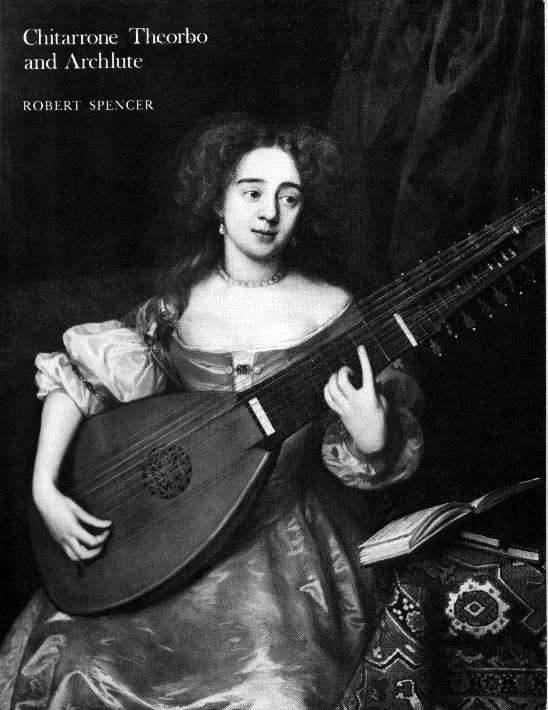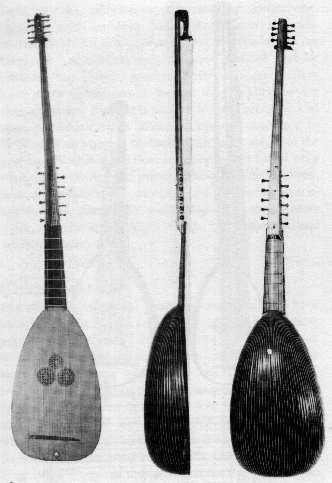
Frontispiece
Lady with a Theorbo (c. 1670?) by John Michael Wright (1617- ?1700) Columbus Gallery of Fine Arts, Ohio, U.S.A.
Defining the differences between the chitarrone, theorbo and archlute has always been difficult. Mersenne (1637) was confused, and few readers of his book on instruments seem to have noticed that he renamed his theorbe, arciliuto. Many modern writers have given definitions as though they applied in any country at any date. It is easy to forget that poor and slow communications allowed regional character to develop. This attempt to distinguish instruments of the lute family with more than one peg box is based on a study of surviving instruments, music written for them, and contemporary comment, not forgetting much appreciated discussion with Michael Lowe, James Tyler, Ian Harwood, Nigel North, Tim Crawford, and Anthony Bailes.
Chitarrone
The chitarrone was most probably evolved c.1580 by a member of the Camerata of Florence, as a necessary adjunct of the new style of song writing, musica recitativa. It supplied simple harmonic support for the voice, often being played by the singer himself. Malvezzi (1591) tells us that Peri sang to his own chitarrone accompaniment in the 1589 feste.1 Piccinini(1623) says that chitarroni were developed from bass lutes, whese strings were raised in pitch (I suggest from D to G) when used for song accompaniment. Owing to the long string-length of the bass lutes the top two courses had to bc lowered an octave. He adds that Caccini used such an instrument to accompany himself before 1594.2 Note that he says nothing about long un-stopped bass strings, which Piccinini says he invented for the arciliuto in 1594. I suggest that before 1594 the chitarrone may have been exactly what Piccinini says: bass lutes restrung at higher pitch with the top two courses lowered an octave, but without very long contrabassi. Such an instrument is shown in Fig. 1.
In 1600 the preface to Cavalieri's Rappresentatione di anima e di Corpo listed 'a chitarrone or theorbo, as it is called' (‘un Chitarone, ò Tiorba che si dica’). That is, by 1600 the words chitarrone and tiorba were considered synonymous, a fact later confirmed by Agazzari (1606), 3 Piccinini (1623)4 and Kapsberger (1640)5 We must therefore consider why there were two names for the same instrument.

Fig 1
Detail from The Duet (c.1630) by Jan Molenaer (1609/10-68), Seattle Art Museum.
The lowest 4 courses of this 10-course instrument are housed in a second peg-box. The same instrument is depicted in Molenaer’s A Young Man and Woman Making Music (c. 1630) in The National Gallery, London, and a similar second peg-box housing the two lowest courses of an 8-course instrument is shown in St Cecilia and the Angel (c. 1610) in the Galleria Nazionale, Rome (illustrated in M. Pincherle, An Illustrated History of Music, London, 1962, P 84).
Three possibilities suggest themselves. First, similar instruments with different names may have been invented simultaneously in different parts of Italy, a supposition backed by the nomenclature of Praetorius (1620): Paduanische Theorba and Lang Romanische Theorba: Chitarron.6 Second, if my suggestion is correct that the earliest chitarrone was only a restrung bass lute, a new name (the tiorba) would have been required for an instrument, which although tuned in a similar manner, had additional long contrabassi strings. By 1600 (S. Rossi, Il primo libro de madrigali) this modification was adopted by the chitarrone. And thirdly, one instrument could have been strung with gut, the other with metal. Both Praetorius and Piccinini mentioned the optional use of metal strings, but neither said that they were exclusive to the chitarrone. Praetorius illustrated both instruments as being single-strung. His chitarron had fourteen courses of which 6 were on the fingerboard, his Paduanische Theorba sixteen courses with eight fingered. His chitarron had a smaller body but longer overall length than his theorba.

Fig 2
Lang Romanische Theorba: Chitarron (detail from plate V) and Paduanische Theorba (detail from plate XVI) wilh their scales marked in Brunswick feet: from M. Praetorius Theatrum Instrumentorum (Wolfenbüttel, 1620). One Brunswick foot equals 11.235 inches or 28. 536cm (N. Bessaraboff, Ancient European Musical Instruments (Boston, 1941, p353). Tunings from M. Praetorius, Syntagma Musicum, Tomus 2: De Organographia (Wolfenbüttel, 1619), P 27.
Apart from these distinctions, which anyway are not confirmed by some large-bodied and double-strung instruments by Buechenberg of Rome, the present state of research does not enable us to state with certainty any difference between chitarrone and tiorba after c. 1600.
Caccini (1602) said that 'the chitarrone is better suited to accompany the voice, especially the tenor, than any other instrument'.7 More than 60 books of songs printed 1600-41 name it for accompaniment.8 In these the player had to improvise a simple chordal accompaniment from a bass line, frequently unfigured, though a few books (Rossi 1600; Kapsberger 1610, 1612, 1619; Corradi 1616) have a tablature accompaniment which gives a precise indication of style. It accompanied the voice without a bowed bass. Banchieri* gave this tuning for a chittarrone:

He did not say whether it was double- or single-strung, nor how many courses were fingered. Note that course 1 could be, and course 2 was at lute pitch, which implies either that the stopped string-length was short, or that Banchieri was unsure of his facts.
Praetorius (1619) also gave a G tuning for his Theorba with 6 stopped strings, which corresponds with his illustration of a chitarron :

Notice that courses 1 and 2 are lowered the octave and that it is single-strung. However, the tablature song accompaniments of Rossi, Kapsberger and Corradi indicate a turning a tone higher, in A. This higher tuning was adopted possibly because a continuo part could be played with greater facility in the much used key of A, as well as those of C, D, E, F and G. Also the instrument would sound better at a higher pitch. Despite the octave displacement of the first two courses, solo music in tablature was printed for the
chitarrone by Kapsberger in 1604, 1616, 1626, 1640, and by Piccinini in 1623. Kapsberger wrote for a 19-course chitarrone in his 1640 book, but courses 15-19 only supply the accidentals missing between courses 6 and 13. Both composers wrote instructions for playing technique, and Piccinini recommended playing with right-hand nails. The Archivo di Stato of Modena has a chitarrone tablature dating from c.1614-19: (MS Musica 4). The word chitarrone, bearing in mind that the instrument was invented by the humanist Camerata, probably means large kithara, the instrument played by the classical Greek poets. The word was last used in printed music in Fontana and Laurenzi 1641 and Cazzati 1653, being gradually replaced during the 1630s by the tiorba.

Fig 3
Chitarrone (? or tiorba) by Magno dieffopruchar (Venice, 1608), ovcrall length 195cm: 6'41/4". London, Royal College of Music, no. 26.
A measured drawing by Ian Harwood of the chitarrone (or tiorba) illustrated (Fig. 3) can be obtained from the Instrument Museum of the Royal College of Music, London. This chitarrone has six double courses on the fingerboard with a stopped string-length of 93.3 cm, and eight single unstopped basses measuring 170.7 cm,